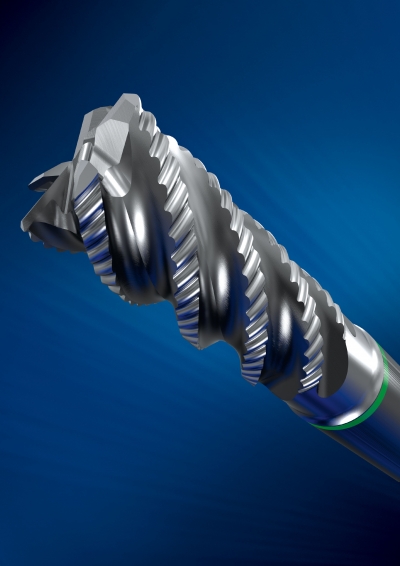
The new GARANT MasterSteel SlotMachine from the Hoffmann Group is a solid-carbide roughing endmill, which achieves high feed rates when slot milling from solid steel. The innovative knuckle form profile produces extremely compact swarf. Therefore, the Hoffmann Group was able to construct the milling cutter with five cutting edges. As a result, at a constant feed rate per tooth the new five-edge end mill achieves 25 percent higher process efficiency than a classic four-edge endmill.
Thanks to the innovative knuckle form profile, the cutting pressure is lower and higher feed rates can be obtained with a constant load. Due to the compact chips and the lower cutting forces, the new GARANT MasterSteel SlotMachine high-performance endmill is particularly suitable both for milling deep slots and for machining delicate components.
Based on its unusual geometry, the new GARANT MasterSteel SlotMachine solid-carbide endmill produces chips that are very short, fine and particularly tightly rolled. These are easily cleared by the flat chip-breaker recesses. The directional chip discharge increases the process reliability, the extremely sturdy core diameter the tool stability.
The GARANT MasterSteel SlotMachine permits plunge angles up to 10 degrees. The cutting edge design includes honing to minimize the risk of break-aways. The ultrafine grain substrate greatly increases the resistance to breakage; while the enhanced coating also optimizes the wear characteristics and reduces the rate of heat input. The unequal spacing ensures a smooth cutting action.
The GARANT MasterSteel SlotMachine achieves a feed rate per tooth up to 0.1 millimeter at cutting depths up to twice the tool diameter (2xD). It is available with cutter diameters from 4 to 20 millimeters.
Contact Details
Related Glossary Terms
- endmill
endmill
Milling cutter held by its shank that cuts on its periphery and, if so configured, on its free end. Takes a variety of shapes (single- and double-end, roughing, ballnose and cup-end) and sizes (stub, medium, long and extra-long). Also comes with differing numbers of flutes.
- feed
feed
Rate of change of position of the tool as a whole, relative to the workpiece while cutting.
- flat ( screw flat)
flat ( screw flat)
Flat surface machined into the shank of a cutting tool for enhanced holding of the tool.
- gang cutting ( milling)
gang cutting ( milling)
Machining with several cutters mounted on a single arbor, generally for simultaneous cutting.
- milling
milling
Machining operation in which metal or other material is removed by applying power to a rotating cutter. In vertical milling, the cutting tool is mounted vertically on the spindle. In horizontal milling, the cutting tool is mounted horizontally, either directly on the spindle or on an arbor. Horizontal milling is further broken down into conventional milling, where the cutter rotates opposite the direction of feed, or “up” into the workpiece; and climb milling, where the cutter rotates in the direction of feed, or “down” into the workpiece. Milling operations include plane or surface milling, endmilling, facemilling, angle milling, form milling and profiling.
- milling cutter
milling cutter
Loosely, any milling tool. Horizontal cutters take the form of plain milling cutters, plain spiral-tooth cutters, helical cutters, side-milling cutters, staggered-tooth side-milling cutters, facemilling cutters, angular cutters, double-angle cutters, convex and concave form-milling cutters, straddle-sprocket cutters, spur-gear cutters, corner-rounding cutters and slitting saws. Vertical cutters use shank-mounted cutting tools, including endmills, T-slot cutters, Woodruff keyseat cutters and dovetail cutters; these may also be used on horizontal mills. See milling.
- milling machine ( mill)
milling machine ( mill)
Runs endmills and arbor-mounted milling cutters. Features include a head with a spindle that drives the cutters; a column, knee and table that provide motion in the three Cartesian axes; and a base that supports the components and houses the cutting-fluid pump and reservoir. The work is mounted on the table and fed into the rotating cutter or endmill to accomplish the milling steps; vertical milling machines also feed endmills into the work by means of a spindle-mounted quill. Models range from small manual machines to big bed-type and duplex mills. All take one of three basic forms: vertical, horizontal or convertible horizontal/vertical. Vertical machines may be knee-type (the table is mounted on a knee that can be elevated) or bed-type (the table is securely supported and only moves horizontally). In general, horizontal machines are bigger and more powerful, while vertical machines are lighter but more versatile and easier to set up and operate.
- swarf
swarf
Metal fines and grinding wheel particles generated during grinding.






